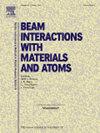Self-ion irradiation of ZrC up to 300 displacements per atom
IF 1.4
3区 物理与天体物理
Q3 INSTRUMENTS & INSTRUMENTATION
Nuclear Instruments & Methods in Physics Research Section B-beam Interactions With Materials and Atoms
Pub Date : 2025-04-18
DOI:10.1016/j.nimb.2025.165695
引用次数: 0
Abstract
ZrC is a candidate fuel matrix for high-temperature gas-cooled reactors and a potential first wall materials for fusion reactors, owing to its high melting point, low neutron capture cross-section, and good mechanical properties. The radiation tolerance of ZrC is critical in such applications. Due to the excessive intrinsic vacancy concentration that naturally occurs in ZrC, it is expected that ZrC has excellent defect recombination efficiencies. In this study, ZrC is manufactured using plasma sintering techniques. Self-ion irradiation by 5 MeV carbon ions is carried out at room temperature, 300 °C, and 600 °C, with ion fluences up to 300 displacements per atom (dpa). Transmission electron microscopy characterization shows that ZrC does not exhibit amorphization under any of these irradiation conditions. No phase changes are observed. Raman spectra display well-separated acoustic and optical bands in the wavenumber region below 800 cm−1. These bands show gradual broadening with increasing damage levels. For wavenumbers higher than 800 cm−1, D and G modes, absent in the virgin sample, appear after irradiation. The increasing D/G mode intensity with rising damage levels suggests localized graphitization. Overall, the study demonstrates the excellent amorphization tolerance of ZrC under extreme conditions.
ZrC的自离子辐照每个原子可达300位位移
ZrC具有高熔点、低中子俘获截面和良好的力学性能,是高温气冷堆的候选燃料基质和聚变堆的潜在第一壁材。ZrC的耐辐射性能在此类应用中至关重要。由于ZrC中固有空位浓度过高,可以预期ZrC具有优异的缺陷复合效率。本研究采用等离子烧结技术制备ZrC。5兆电子伏特碳离子的自离子辐照在室温、300°C和600°C下进行,离子影响可达每原子300位移(dpa)。透射电镜表征表明,在任何这些辐照条件下,ZrC都没有表现出非晶化。未观察到相变。拉曼光谱在800 cm−1以下的波数区显示出分离良好的声光带。随着损伤程度的增加,这些谱带逐渐变宽。对于高于800 cm−1的波数,辐照后出现了原始样品中不存在的D和G模式。D/G模式强度随损伤程度的增加而增加,表明局部石墨化。总的来说,该研究证明了ZrC在极端条件下具有优异的非晶化耐受性。
本文章由计算机程序翻译,如有差异,请以英文原文为准。
求助全文
约1分钟内获得全文
求助全文
来源期刊
CiteScore
2.80
自引率
7.70%
发文量
231
审稿时长
1.9 months
期刊介绍:
Section B of Nuclear Instruments and Methods in Physics Research covers all aspects of the interaction of energetic beams with atoms, molecules and aggregate forms of matter. This includes ion beam analysis and ion beam modification of materials as well as basic data of importance for these studies. Topics of general interest include: atomic collisions in solids, particle channelling, all aspects of collision cascades, the modification of materials by energetic beams, ion implantation, irradiation - induced changes in materials, the physics and chemistry of beam interactions and the analysis of materials by all forms of energetic radiation. Modification by ion, laser and electron beams for the study of electronic materials, metals, ceramics, insulators, polymers and other important and new materials systems are included. Related studies, such as the application of ion beam analysis to biological, archaeological and geological samples as well as applications to solve problems in planetary science are also welcome. Energetic beams of interest include atomic and molecular ions, neutrons, positrons and muons, plasmas directed at surfaces, electron and photon beams, including laser treated surfaces and studies of solids by photon radiation from rotating anodes, synchrotrons, etc. In addition, the interaction between various forms of radiation and radiation-induced deposition processes are relevant.

 求助内容:
求助内容: 应助结果提醒方式:
应助结果提醒方式:


